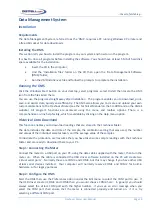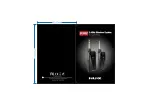
...the
art
of
distell
‐
ing...
Freshness
Meter
User
Manual
Page
6
For
known
species
–
one
for
which
an
organoleptic
chart
exists
–
the
procedure
is
simple.
Take
a
meter
reading
from
a
sample
of
your
required
species;
the
result,
measured
on
the
Torry
Freshness
Scale,
should
be
between
16
for
fresh
and
1
for
spoiled.
Then
refer
to
the
relevant
organoleptic
chart
for
an
interpretation
of
the
meter
reading
and
its
implication
for
the
freshness
of
your
sample.
For
example,
if
you
wish
to
sample
cod
which
is
boxed
between
catch
and
port,
refer
to
the
first
chart
in
charts’.
This
chart
shows
that
a
meter
reading
of
16
represents
a
fish
of
less
than
2
days
old.
A
reading
of
8
would
indicate
that
the
fish
was
10
days
old
and
a
reading
of
below
3
would
indicate
that
the
fish
was
more
than
18
days
old,
and
spoiled.
If
the
species
is
not
known
and
has
no
organoleptic
chart,
you
can
perform
a
custom
calibration
exercise
in
which
you
generate
a
chart
for
future
reference.
To
do
this,
take
a
set
of
readings
for
the
fish
as
it
decays
from
fresh
to
spoiled.
This
may
give
a
reasonable
set
of
readings
from
somewhere
near
16
(fresh)
to
3
or
below
when
spoiled.
If
this
is
in
fact
the
case,
the
readings
can
be
used
to
write
into
an
organoleptic
chart
which
becomes
the
reference
for
the
new
species.
Alternatively
however
you
may
find
that
the
range
of
readings
as
the
fish
decays
from
fresh
to
putrid
is
too
narrow
for
useful
interpretation.
For
example
you
may
see
an
initial
reading
of
12
when
fresh
and
8
when
spoiled.
The
answer
is
to
use
the
full
internal
range
of
the
meter,
which
has
much
more
resolution
available
than
the
scales
available
with
the
TORRY
‐
1
(0.1
to
18.5)
or
TORRY
‐
STD
(1
to
18)
scales.
The
internal
range
is
accessed
using
the
RESEARCH
‐
1
calibration,
which
offers
a
range
of
0.1
to
above
99.9.
By
taking
a
second
set
of
readings
using
this
higher
resolution
you
will
be
able
to
obtain
a
set
of
meaningfully
differentiated
readings
over
the
narrow
range
of
the
12
–
8
example
above.
Having
obtained
a
reference
dataset
of
such
readings
over
the
period
from
fresh
to
putrid
you
can:
a.
Simply
continue
using
this
dataset
as
a
reference
for
future
measurements
of
the
same
species,
or
b.
Load
the
data
into
a
spreadsheet
for
further
analysis
or
reference,
or
c.
Generate
an
Analysis
Dataset
of
equal
daily
decrements
from
18
to
1,
and
use
this
within
the
Data
Management
System
to
scale
the
Reference
Dataset
readings.
The
scaled
output
dataset
becomes
the
new
custom
calibration
for
the
new
species;
it
can
be
stored
in
the
meter
and
entered
into
a
new
Organoleptic
Chart.
You
can
refer
to
the
Freshness
Meter
Technical
Manual,
on
the
CD
‐
ROM
and
on
the
Distell
website,
for
more
information
on
custom
calibrations.
General
description
This
latest
model
of
the
Fish
Freshness
Meter
is
compact,
robust,
fully
portable
and
suitable
for
any
normal
application
within
fish
processing
industry
markets,
processing
factories
or
quality
control
laboratories.
It
provides
rapid
measurements
and
is
simple
to
use.
The
freshness
of
the
fish
is
indicated
on
the
LCD
display.
The
meter
can
be
set
to
measure
from
1
‐
16
fish.
The
menu
driven
software
will
sum
the
readings
of
all
the
samples
and
then
display
their
average
value.
The
meter
is
most
accurate
in
this
mode.
Generally
the
measurements
can
be
taken
without
disturbing
the
fish
in
their
containers,
and
the
testing
does
not
damage
or
mark
the
samples
in
any
way.
Principle
of
operation
The
original
research
leading
to
the
development
of
the
Fish
Freshness
Meter
was
carried
out
at
Torry
Research
Station,
in
Aberdeen,
Scotland.







































